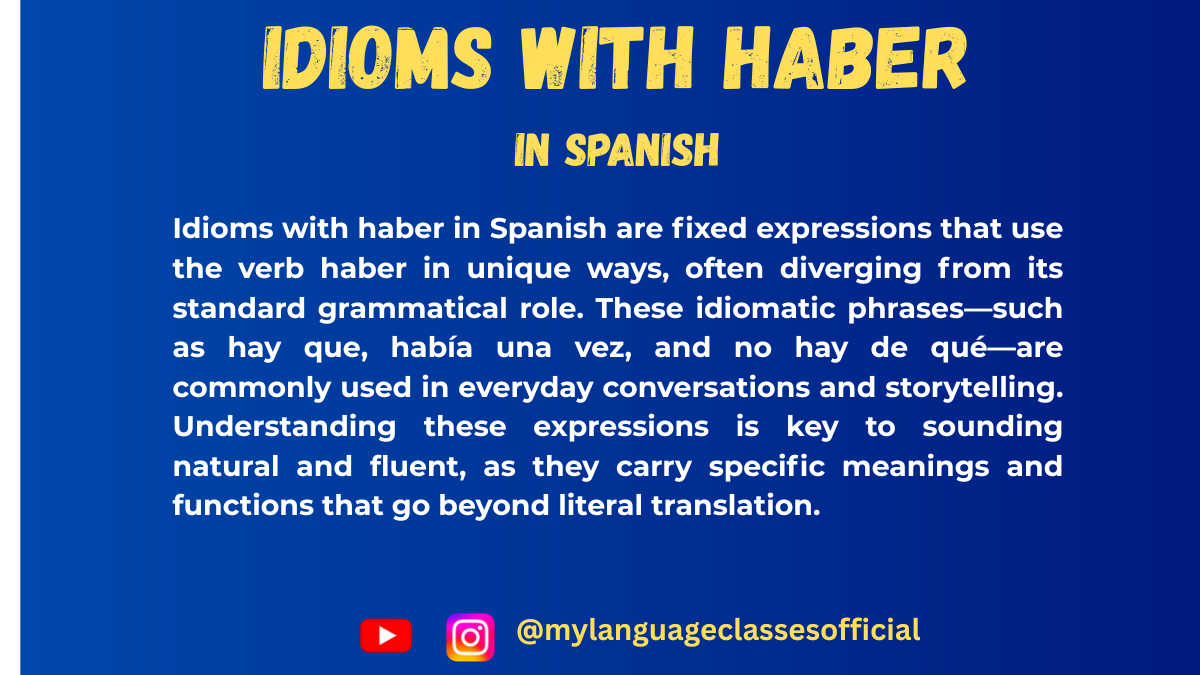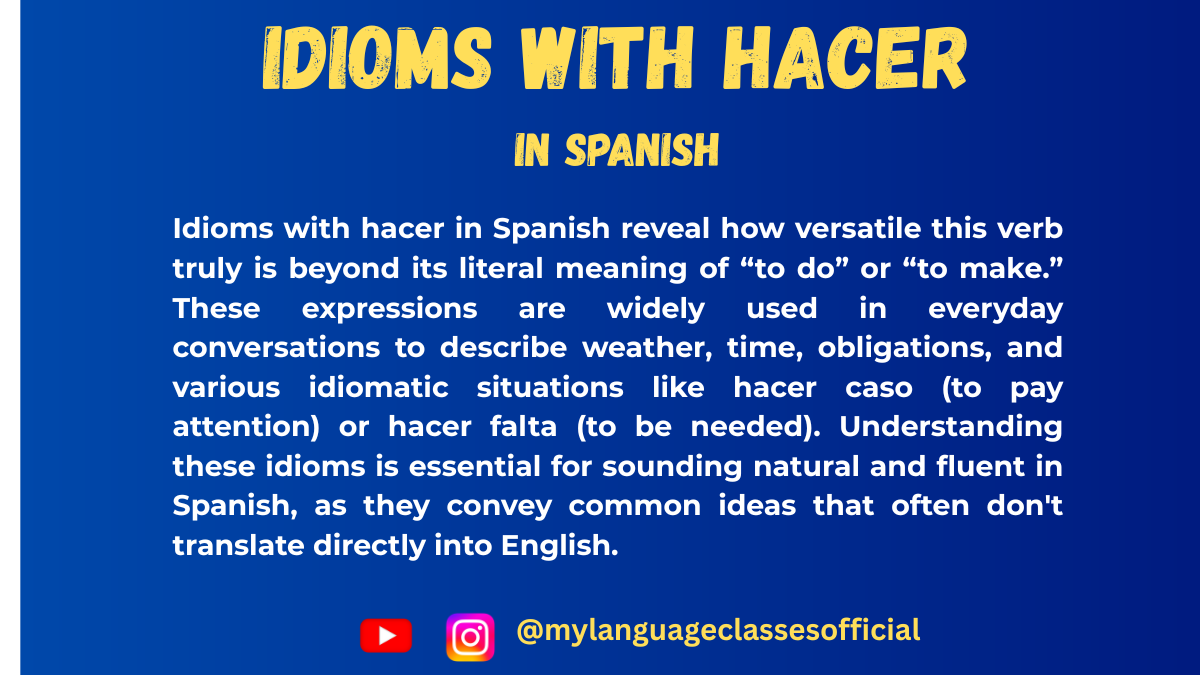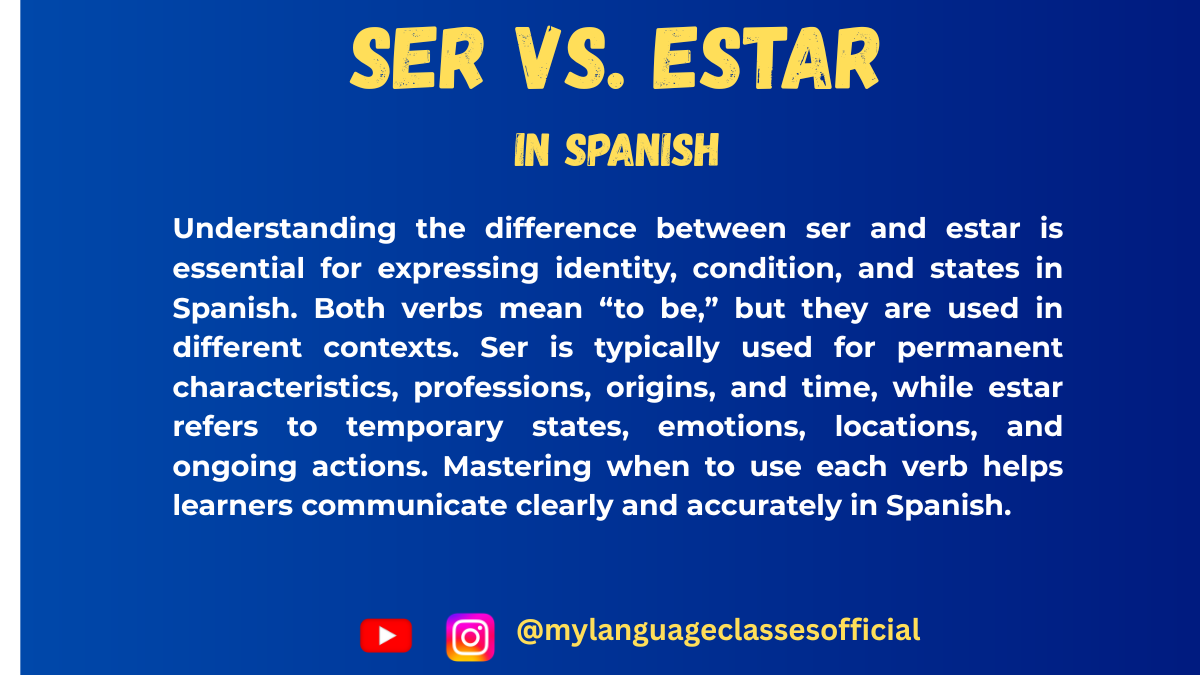Your cart is currently empty!
Category: Verbs in Spanish
Master the use of Spanish verbs with clear lessons on regular and irregular conjugations, verb tenses, moods, and real-life usage. Learn how to express actions and ideas accurately in past, present, and future contexts. Ideal for all learners from beginner to advanced levels.
-
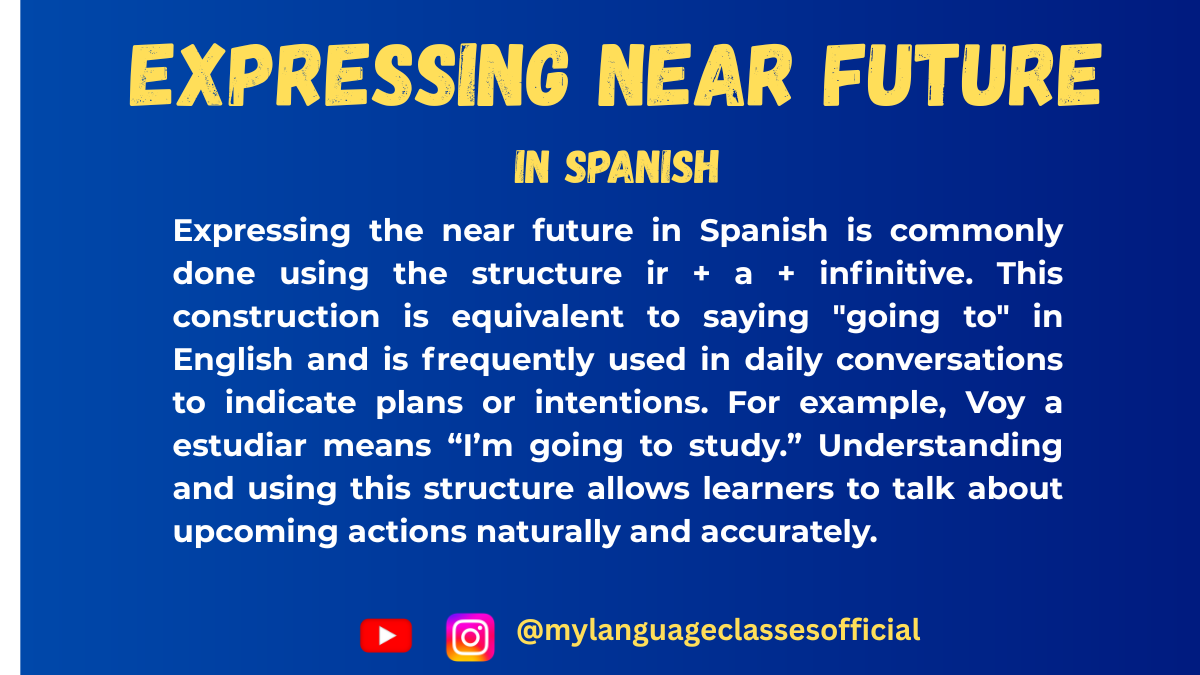
Ir a + Infinitive: Expressing Near Future in Spanish
Ir a + Infinitive: Expressing Near Future in Spanish
In Spanish, the construction “Ir a + infinitive” is commonly used to express actions that will happen in the near future. This is equivalent to the English “going to + verb” structure. It is widely used in spoken and written Spanish and is easier to learn compared to the simple future tense.
Formation of “Ir a + Infinitive”
The structure consists of three elements:
- The verb “ir” (to go) conjugated in the present tense.
- The preposition “a” (to).
- An infinitive verb (unconjugated verb).
Conjugation of “Ir” in Present Tense:
Subject Pronoun Conjugation of “Ir” Yo voy Tú vas Él/Ella/Usted va Nosotros/as vamos Vosotros/as vais Ellos/Ellas/Ustedes van Sentence Structure:
Subject + Ir (conjugated) + a + Infinitive Verb
Example Sentences:
- Voy a estudiar. (I am going to study.)
- Vamos a viajar a México. (We are going to travel to Mexico.)
- Ellos van a comprar una casa. (They are going to buy a house.)
Usage of “Ir a + Infinitive”
1. Near Future Actions
Used to express something that is about to happen soon.
- Voy a llamar a mi madre. (I am going to call my mother.)
- Ella va a cocinar la cena. (She is going to cook dinner.)
2. Intentions or Plans
Used when someone has planned to do something.
- Vamos a ver una película esta noche. (We are going to watch a movie tonight.)
- Voy a aprender español este año. (I am going to learn Spanish this year.)
3. Predictions Based on Evidence
Used when there is evidence that something is about to happen.
- Va a llover. (It is going to rain.)
- El bebé va a llorar. (The baby is going to cry.)
4. Giving Commands or Warnings
Used to give warnings or strong suggestions.
- Vas a romper el vaso. (You are going to break the glass.)
- Van a llegar tarde si no se apuran. (You all are going to be late if you don’t hurry.)
Articles, Gender, and Plural Considerations
When using “Ir a + Infinitive,” remember:
- Definite Articles (el, la, los, las) and Indefinite Articles (un, una, unos, unas) should match the noun in gender and number.
- Example: Voy a comprar una bicicleta. (I am going to buy a bicycle.)
- Example: Vamos a visitar el museo. (We are going to visit the museum.)
- Verb agreement: The conjugation of “ir” changes based on the subject.
- The infinitive verb does not change regardless of the subject.
Common Verbs Used with “Ir a + Infinitive”
Here is a list of common verbs and their “Ir a + Infinitive” forms:
Infinitive Verb Meaning “Ir a + Infinitive” Example Comer To eat Voy a comer pizza. (I am going to eat pizza.) Beber To drink Vas a beber agua. (You are going to drink water.) Estudiar To study Ella va a estudiar matemáticas. (She is going to study mathematics.) Viajar To travel Vamos a viajar a España. (We are going to travel to Spain.) Comprar To buy Van a comprar un coche. (They are going to buy a car.) Hacer To do/make Voy a hacer mi tarea. (I am going to do my homework.) Tener To have Vas a tener una sorpresa. (You are going to have a surprise.) Llegar To arrive Ella va a llegar temprano. (She is going to arrive early.) Jugar To play Vamos a jugar fútbol. (We are going to play soccer.) Dormir To sleep Van a dormir temprano. (They are going to sleep early.) Regular and Irregular Verbs in “Ir a + Infinitive”
All verbs, whether regular or irregular, remain in the infinitive form after “a.”
Regular Verbs (AR, ER, IR Verbs)
- Hablar (to speak): Voy a hablar con mi amigo. (I am going to speak with my friend.)
- Comer (to eat): Vamos a comer paella. (We are going to eat paella.)
- Vivir (to live): Ellos van a vivir en Barcelona. (They are going to live in Barcelona.)
Irregular Verbs
- Hacer (to do/make): Voy a hacer la tarea. (I am going to do the homework.)
- Tener (to have): Ella va a tener una fiesta. (She is going to have a party.)
- Poder (to be able to): Van a poder salir temprano. (They are going to be able to leave early.)
Conclusion
The “Ir a + Infinitive” structure is one of the most practical and commonly used ways to express the near future in Spanish. It is simple to form and widely understood in all Spanish-speaking regions. By practicing this structure with different verbs, you can quickly improve your Spanish fluency and express future plans with confidence.
Now that you understand how to use “Ir a + Infinitive”, start practicing by forming your own sentences!
If you found this guide helpful, I’d love to hear from you! Share your thoughts in the comments below or connect with me on social media. For more tips, resources, and inspiration, visit my blog at mylanguageclasses.in. Follow on Instagram and subscribe on YouTube
📚 Continue Learning Spanish
-
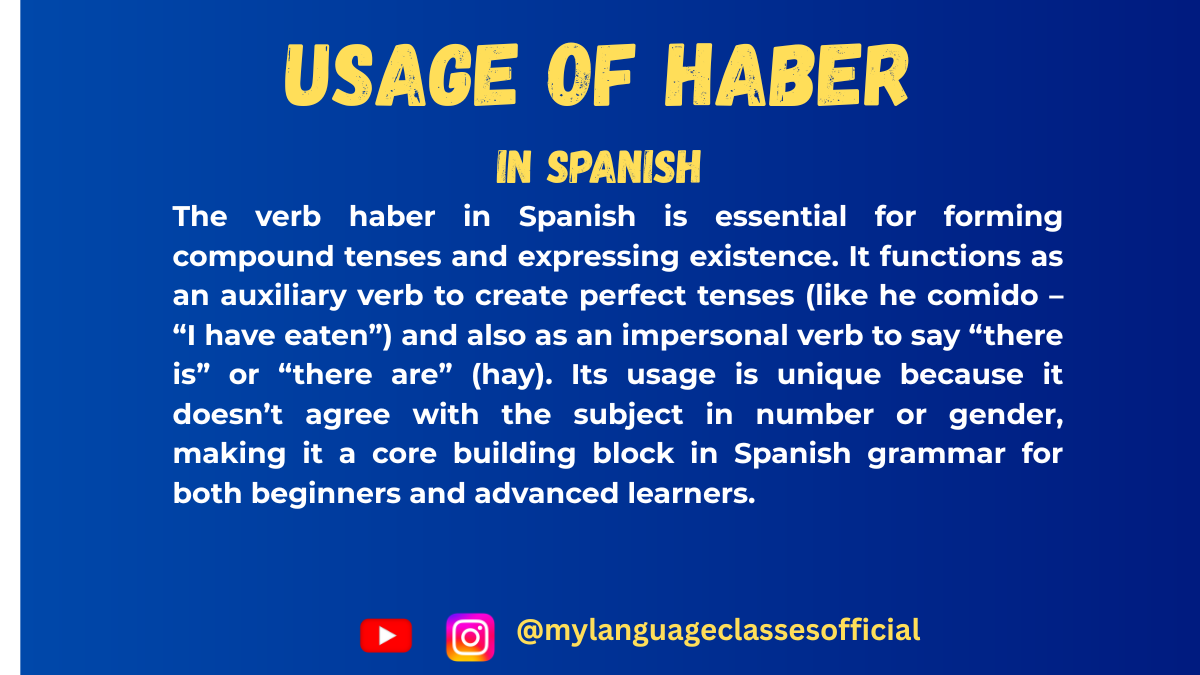
Mastering Haber in Spanish
Mastering “Haber” in Spanish
The Spanish verb haber is one of the most versatile and fundamental verbs in the language. Understanding its uses, forms, and common expressions is essential for communicating effectively in Spanish. In this blog post, we will explore the different contexts in which “haber” is used, along with a list of commonly used expressions and examples.
1. What Is “Haber”?
“Haber” is an irregular verb in Spanish that serves multiple grammatical purposes. It does not directly translate into English but has different meanings and uses depending on the context. It can function as:
- An auxiliary verb: To form compound tenses.
- An impersonal verb: To express existence.
- Part of idiomatic expressions: Used in fixed phrases common in daily speech.
2. Forms of “Haber”
The conjugation of “haber” varies greatly depending on the tense and mood. Here are some key forms:
Present tense (indicative):
- He, has, ha, hemos, habéis, han
Past tense (preterite):
- Hube, hubiste, hubo, hubimos, hubisteis, hubieron
Imperfect tense:
- Había, habías, había, habíamos, habíais, habían
Subjunctive mood (present):
- Haya, hayas, haya, hayamos, hayáis, hayan
Impersonal form (used in expressions):
- Hay (present), hubo (preterite), había (imperfect)
3. Key Uses of “Haber”
A. As an Auxiliary Verb
“Haber” is used to form compound tenses, similar to “have” in English. It combines with the past participle of the main verb.
- Present Perfect (Pretérito Perfecto): Used to talk about actions that happened in the past but are relevant to the present.
- Example: He comido. (I have eaten.)
- Past Perfect (Pluscuamperfecto): Describes actions that occurred before another past action.
- Example: Había estudiado antes del examen. (I had studied before the exam.)
- Future Perfect (Futuro Perfecto): Refers to actions that will have been completed by a certain point in the future.
- Example: Habré terminado para las cinco. (I will have finished by five.)
B. As an Impersonal Verb
“Haber” is used in its impersonal form to express existence. The subject is not a person, and it is typically followed by a noun.
- Present Tense:Hay (There is/There are)
- Example: Hay un libro en la mesa. (There is a book on the table.)
- Example: Hay muchas flores en el jardín. (There are many flowers in the garden.)
- Past Tense:
- Hubo (preterite): Refers to events or existence at a specific moment in the past.
- Example: Hubo un accidente en la carretera. (There was an accident on the road.)
- Había (imperfect): Describes an ongoing or habitual past situation.
- Example: Había mucha gente en la fiesta. (There were many people at the party.)
- Hubo (preterite): Refers to events or existence at a specific moment in the past.
- Future Tense:Habrá (There will be)
- Example: Habrá una reunión mañana. (There will be a meeting tomorrow.)
C. Common Expressions with “Haber”
Here are some of the most common idiomatic expressions with “haber,” their meanings, and example sentences:
- Hay que + infinitive
Meaning: One must/It is necessary to.- Example: Hay que estudiar para aprobar el examen. (One must study to pass the exam.)
- Haber de + infinitive
Meaning: To have to (mild obligation or future intention).- Example: He de hablar con ella. (I must talk to her.)
- Haber lugar
Meaning: To have room or to be possible.- Example: No hay lugar para más invitados. (There is no room for more guests.)
- No hay de qué
Meaning: You’re welcome (literally, there is no reason to thank).- Example: Gracias por tu ayuda. No hay de qué. (Thanks for your help. You’re welcome.)
- Haber que ver con
Meaning: To have to do with something.- Example: Eso no tiene nada que ver conmigo. (That has nothing to do with me.)
- Habérselas con alguien
Meaning: To deal with someone (often confrontational).- Example: Hoy me las he tenido que ver con mi jefe. (Today, I had to deal with my boss.)
4. Things to Keep in Mind
When using “haber,” remember the following:
Articles and Gender:
- “Haber” in its impersonal form (hay, hubo, habrá) is not influenced by the gender or plurality of the noun that follows.
- Correct: Hay una silla. (There is a chair.)
- Correct: Hay cinco sillas. (There are five chairs.)
Auxiliary Verb Agreement:
- When used as an auxiliary verb, “haber” agrees with the subject of the sentence, not the object.
- Correct: He visto la película. (I have seen the movie.)
Idiomatic Nuance:
- Expressions like hay que are impersonal and do not conjugate for different subjects.
5. Practice and Examples
To master “haber,” practice by forming sentences in different tenses and exploring idiomatic expressions. For example:
- Hay un perro en el parque. (There is a dog in the park.)
- Había una vez un rey. (Once upon a time, there was a king.)
- Habrá una gran sorpresa en la fiesta. (There will be a big surprise at the party.)
Final Thoughts
Mastering “haber” is a key step in becoming fluent in Spanish. Whether forming compound tenses, expressing existence, or using idiomatic expressions, this verb is integral to daily communication. Keep practicing, and soon, it will become second nature.
Do you have favorite expressions with “haber”? Share them in the comments!
If you found this guide helpful, I’d love to hear from you! Share your thoughts in the comments below or connect with me on social media. For more tips, resources, and inspiration, visit my blog at mylanguageclasses.in. Follow on Instagram and subscribe on YouTube
📚 Continue Learning Spanish
-
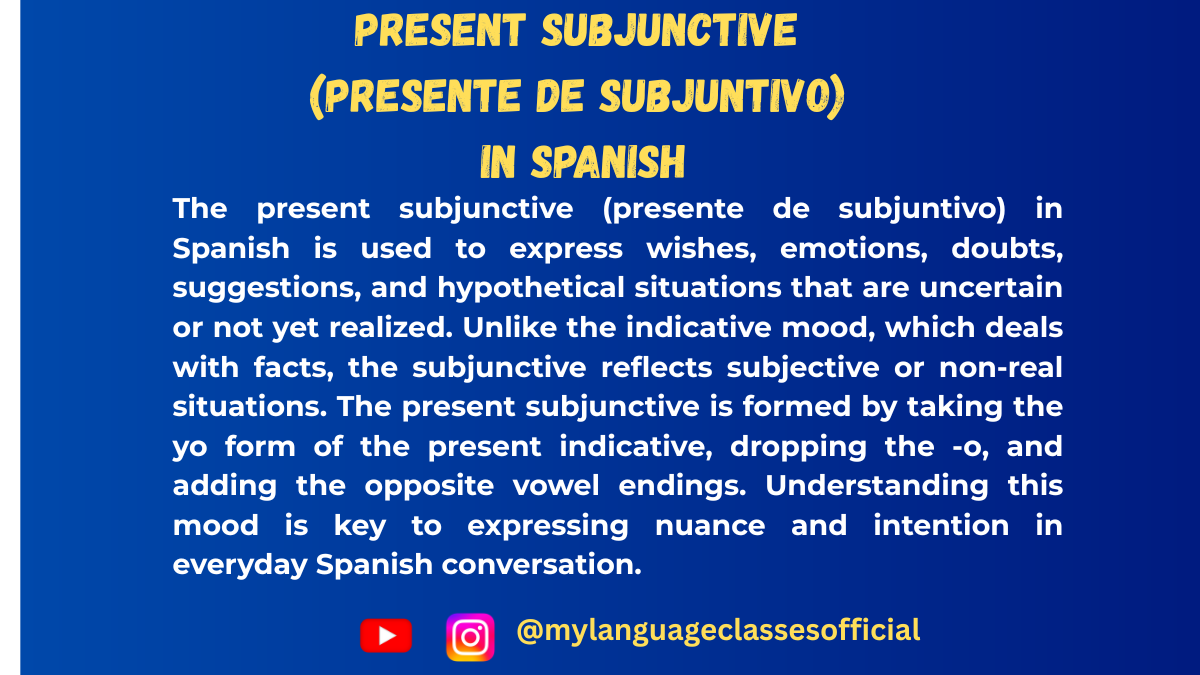
Present Subjunctive (Presente de Subjuntivo) in Spanish
Understanding the Present Subjunctive (Presente de Subjuntivo) in Spanish
The Present Subjunctive (Presente de Subjuntivo) is a crucial concept in Spanish that expresses doubt, wishes, emotions, and subjective perceptions. Unlike the indicative, which is used for facts and certainty, the subjunctive emphasizes what is hypothetical, uncertain, or emotionally influenced.
Situations Where the Presente de Subjuntivo Is Used
- Expressions of Desire or Influence
Used when one person wants another person to do something.- Trigger Phrases: “Quiero que,” “Deseo que,” “Prefiero que.”
- Example:
- Indicative: Quiero aprender español. (I want to learn Spanish.)
- Subjunctive: Quiero que tú aprendas español. (I want you to learn Spanish.)
- Expressions of Doubt or Denial
Used with uncertainty or disbelief.- Trigger Phrases: “Dudo que,” “No creo que,” “Es posible que.”
- Example:
- Dudo que ella venga a la fiesta. (I doubt that she will come to the party.)
- Emotions and Reactions
Used to express feelings about actions or situations.- Trigger Phrases: “Me alegra que,” “Siento que,” “Temo que.”
- Example:
- Me alegra que tú estés aquí. (I’m glad you’re here.)
- Impersonal Expressions of Uncertainty or Emotion
When impersonal phrases signal subjectivity or uncertainty.- Trigger Phrases: “Es importante que,” “Es necesario que,” “Es increíble que.”
- Example:
- Es importante que estudiemos para el examen. (It’s important that we study for the exam.)
- Conjunctions That Express Future Uncertainty
Subjunctive is used after certain conjunctions if the action is uncertain or hasn’t occurred yet.- Trigger Conjunctions: “Para que,” “A menos que,” “Antes de que.”
- Example:
- Te lo explico para que lo entiendas. (I’ll explain it so you understand.)
- Negative Commands
For giving instructions to not do something.- Example:
- No hables con él. (Don’t talk to him.)
- Example:
Conjugating Verbs in the Presente de Subjuntivo
To conjugate regular verbs in the Present Subjunctive, follow these steps:
- Start with the first-person singular (yo) form of the verb in the present indicative.
- Remove the “-o” ending.
- Add the appropriate subjunctive ending based on the verb’s group (-AR, -ER, -IR).
Endings for Regular Verbs
Verb Group Yo Tú Él/Ella/Usted Nosotros/Nosotras Vosotros/Vosotras Ellos/Ellas/Ustedes -AR -e -es -e -emos -éis -en -ER -a -as -a -amos -áis -an -IR -a -as -a -amos -áis -an Examples of Regular Verbs
- Hablar (to speak)
- yo hable, tú hables, él/ella/usted hable, nosotros/nosotras hablemos, vosotros/vosotras habléis, ellos/ellas/ustedes hablen.
- Comer (to eat)
- yo coma, tú comas, él/ella/usted coma, nosotros/nosotras comamos, vosotros/vosotras comáis, ellos/ellas/ustedes coman.
- Vivir (to live)
- yo viva, tú vivas, él/ella/usted viva, nosotros/nosotras vivamos, vosotros/vosotras viváis, ellos/ellas/ustedes vivan.
Irregular Verbs in the Presente de Subjuntivo
Certain verbs are irregular in the Present Subjunctive and do not follow the standard rules. Below is a table of commonly used irregular verbs with their conjugations.
Verb Yo Tú Él/Ella/Usted Nosotros/Nosotras Vosotros/Vosotras Ellos/Ellas/Ustedes Ser sea seas sea seamos seáis sean Ir vaya vayas vaya vayamos vayáis vayan Estar esté estés esté estemos estéis estén Saber sepa sepas sepa sepamos sepáis sepan Haber haya hayas haya hayamos hayáis hayan Dar dé des dé demos deis den Ver vea veas vea veamos veáis vean
Important Tips for Using the Presente de Subjuntivo
- Check for Triggers: The subjunctive is rarely used alone. Look for expressions that require it.
- Mind the Gender and Plurality: Match adjectives and nouns appropriately in gender (masculine/feminine) and number (singular/plural).
- Example: Es importante que las estudiantes estén preparadas.
- Distinguish Context: Ensure you use the subjunctive only when necessary to avoid confusion with the indicative.
- Practice Common Phrases: Memorize phrases where the subjunctive is frequently used to internalize its application.
By mastering the Presente de Subjuntivo, you open the door to expressing more nuanced thoughts and emotions in Spanish. Practice regularly, and don’t hesitate to use examples as guides in your learning journey. ¡Buena suerte!
If you found this guide helpful, I’d love to hear from you! Share your thoughts in the comments below or connect with me on social media. For more tips, resources, and inspiration, visit my blog at mylanguageclasses.in. Follow on Instagram and subscribe on YouTube
📚 Continue Learning Spanish
- Expressions of Desire or Influence
-
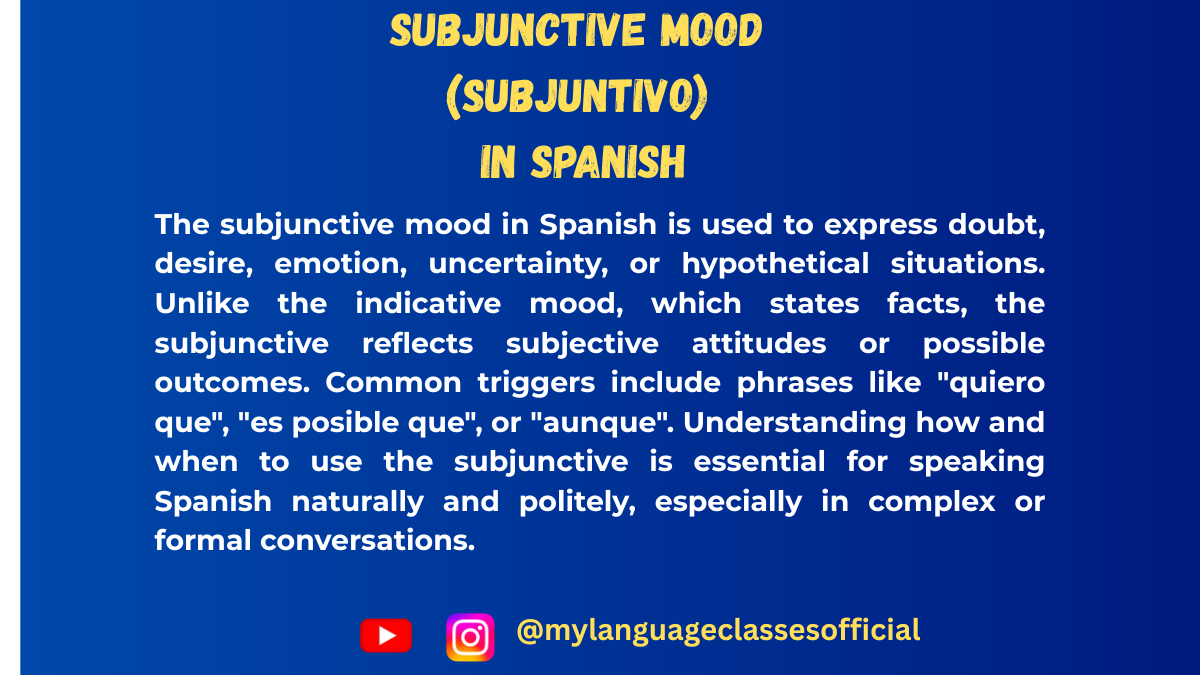
Subjunctive Mood in Spanish
Understanding the Subjunctive Mood in Spanish
The subjunctive mood is one of the most challenging yet fascinating aspects of Spanish for learners. Unlike the indicative mood, which deals with facts, realities, and concrete statements, the subjunctive is used to express uncertainty, subjectivity, emotions, desires, hypothetical situations, and more. Mastering when to use the subjunctive mood is essential for sounding natural and fluent in Spanish.
Key Characteristics of the Subjunctive Mood
- Subjectivity and Uncertainty The subjunctive mood is used when the speaker expresses doubt, uncertainty, or subjectivity. It contrasts with the indicative, which conveys certainty and objective facts.
- Dependent on Context Subjunctive verbs often appear in subordinate clauses introduced by conjunctions like que (that). The verb in the main clause typically triggers the subjunctive in the subordinate clause.
Situations Where the Subjunctive Mood is Used
1. Wishes, Desires, and Requests
Use the subjunctive when expressing a wish or desire about someone or something else. Common verbs that trigger this usage include querer (to want), esperar (to hope), and desear (to wish).
- Example:
- Indicative: Quiero que tú vienes. (Incorrect)
- Subjunctive: Quiero que tú vengas. (I want you to come.)
Note: The subject in the main clause is different from the subject in the subordinate clause.
2. Emotions
When expressing feelings such as joy, sadness, surprise, or fear about something, the subjunctive is used.
- Example:
- Indicative: Me alegra que tienes tiempo. (Incorrect)
- Subjunctive: Me alegra que tengas tiempo. (I’m glad you have time.)
3. Doubt and Denial
The subjunctive is required when there is doubt, denial, or disbelief about an action or state. Verbs like dudar (to doubt) and negar (to deny) often signal this.
- Example:
- Indicative: Dudo que es verdad. (Incorrect)
- Subjunctive: Dudo que sea verdad. (I doubt it is true.)
Note: If there is no doubt, use the indicative:
- No dudo que es verdad. (I don’t doubt it’s true.)
4. Impersonal Expressions
Certain impersonal expressions followed by que require the subjunctive. These include expressions of necessity, possibility, or subjective judgment.
- Common expressions:
- Es importante que… (It’s important that…)
- Es posible que… (It’s possible that…)
- Es extraño que… (It’s strange that…)
- Example:
- Indicative: Es posible que él tiene razón. (Incorrect)
- Subjunctive: Es posible que él tenga razón. (It’s possible he’s right.)
5. Hypothetical Situations
Use the subjunctive to describe hypothetical or non-existent situations, especially in sentences starting with si (if).
- Example:
- Subjunctive: Si tuviera dinero, viajaría más. (If I had money, I would travel more.)
6. Conjunctions of Contingency and Purpose
The subjunctive follows certain conjunctions that imply purpose, condition, or a future action. These include:
- para que (so that)
- a menos que (unless)
- antes de que (before)
- Example:
- Indicative: Estudio para que puedo aprender. (Incorrect)
- Subjunctive: Estudio para que pueda aprender. (I study so that I can learn.)
7. Unrealized Actions
Use the subjunctive when the action hasn’t yet been completed or is anticipated.
- Example:
- Indicative: Cuando llegas, hablamos. (Incorrect)
- Subjunctive: Cuando llegues, hablaremos. (When you arrive, we’ll talk.)
Subjunctive vs. Indicative: A Quick Comparison
Indicative Subjunctive Expresses certainty and facts. Expresses doubt, subjectivity, or uncertainty. Example: Sé que él viene. (I know he’s coming.) Example: No creo que él venga. (I don’t think he’s coming.)
Gender, Articles, and Agreement in Subjunctive Sentences
- Articles: Use definite articles (el, la, los, las) when referring to something specific and indefinite articles (un, una, unos, unas) for non-specific references.
- Example: Es importante que el profesor explique bien.
- Gender and Plurality: Adjectives and nouns in the subjunctive sentence must agree in gender and number.
- Example: Es raro que las niñas estén calladas. (It’s strange that the girls are quiet.)
- Pronoun Placement: Pronouns like me, te, lo, la, nos, os, los, las must be placed correctly depending on verb forms in subjunctive sentences.
Things to Keep in Mind
- Always pay attention to the trigger verb or expression in the main clause.
- The subjunctive is usually required when there’s a change in subject between clauses.
- Don’t confuse formal subjunctive structures with casual, everyday Spanish, which might omit the subjunctive in informal speech.
By understanding the situations where the subjunctive mood is required and practicing it in real-life contexts, you’ll be able to express yourself more naturally in Spanish. Remember, the subjunctive isn’t just a grammar rule—it’s a way of capturing the nuances of emotions, possibilities, and perspectives in communication!
If you found this guide helpful, I’d love to hear from you! Share your thoughts in the comments below or connect with me on social media. For more tips, resources, and inspiration, visit my blog at mylanguageclasses.in. Follow on Instagram and subscribe on YouTube
📚 Continue Learning Spanish
-

Present Perfect Tense (Pretérito Perfecto de Indicativo) in Spanish
Present Perfect Tense (Pretérito Perfecto de Indicativo) in Spanish
The Pretérito Perfecto de Indicativo is a crucial tense in Spanish, used to describe actions or events that are connected to the present or have relevance to it. In English, it corresponds to the Present Perfect tense (e.g., “I have eaten”).
What is the Pretérito Perfecto de Indicativo?
The Pretérito Perfecto is used to describe:
- Actions that happened in the recent past and are relevant now.
- Hoy he estudiado mucho.
(Today I have studied a lot.)
- Hoy he estudiado mucho.
- Experiences or actions that have occurred at some point in life without specifying when.
- ¿Alguna vez has viajado a España?
(Have you ever traveled to Spain?)
- ¿Alguna vez has viajado a España?
- Actions within a time frame that has not yet ended (this week, this month, etc.).
- Esta semana hemos ido al cine dos veces.
(This week we have gone to the movies twice.)
- Esta semana hemos ido al cine dos veces.
- Unfinished past actions or those seen as having ongoing effects in the present.
- He vivido en Madrid durante tres años.
(I have lived in Madrid for three years.)
- He vivido en Madrid durante tres años.
How to Form the Pretérito Perfecto de Indicativo
This tense is formed with the present tense of the auxiliary verb “haber” + the past participle of the main verb.
1. Conjugation of “Haber” (to have)
This verb acts as an auxiliary verb in this tense. Below is its conjugation:
Subject Conjugation of Haber Yo he Tú has Él/Ella/Usted ha Nosotros/as hemos Vosotros/as habéis Ellos/Ellas/Ustedes han 2. Formation of the Past Participle
To form the past participle:
- For -AR verbs: Replace -ar with -ado.
- Hablar → Hablado (spoken)
- For -ER/-IR verbs: Replace -er/-ir with -ido.
- Comer → Comido (eaten)
- Vivir → Vivido (lived)
Irregular Past Participles:
Many verbs have irregular past participles. Here are some common ones:
Verb Past Participle English Abrir Abierto Opened Decir Dicho Said Escribir Escrito Written Hacer Hecho Done/Made Ver Visto Seen Volver Vuelto Returned Poner Puesto Put Romper Roto Broken
Common Expressions Using the Pretérito Perfecto
These phrases are frequently used with the Pretérito Perfecto to provide a context for the action:
- Hoy – Today
- Hoy he terminado el informe.
(Today I have finished the report.)
- Hoy he terminado el informe.
- Esta semana – This week
- Esta semana hemos tenido muchas reuniones.
(This week we have had many meetings.)
- Esta semana hemos tenido muchas reuniones.
- Alguna vez – Ever
- ¿Alguna vez has probado el sushi?
(Have you ever tried sushi?)
- ¿Alguna vez has probado el sushi?
- Nunca – Never
- Nunca he estado en Italia.
(I have never been to Italy.)
- Nunca he estado en Italia.
- Ya – Already
- Ya hemos hecho la tarea.
(We have already done the homework.)
- Ya hemos hecho la tarea.
- Todavía no – Not yet
- Todavía no han llegado.
(They have not arrived yet.)
- Todavía no han llegado.
- Recientemente – Recently
- Recientemente he leído un libro interesante.
(I have recently read an interesting book.)
- Recientemente he leído un libro interesante.
Key Grammar Rules and Considerations
- Gender and Number Agreement
The past participle does not change to agree with the subject because it is part of a compound tense.- Ellos han comido.
(They have eaten.) - Ella ha comido.
(She has eaten.)
- Ellos han comido.
- Object Pronouns
Object pronouns are placed before “haber.”- Me he levantado temprano.
(I have gotten up early.) - Nos hemos perdido en la ciudad.
(We have gotten lost in the city.)
- Me he levantado temprano.
- Negative Sentences
Place “no” before “haber.”- No he terminado el proyecto.
(I have not finished the project.)
- No he terminado el proyecto.
Conjugation Examples for Regular Verbs
1. -AR Verbs: Hablar (to speak)
Subject Conjugation Example Sentence Yo he hablado He hablado con mi amigo. Tú has hablado ¿Has hablado con ella? Él/Ella/Usted ha hablado Ha hablado mucho hoy. Nosotros/as hemos hablado Hemos hablado del problema. Vosotros/as habéis hablado Habéis hablado demasiado. Ellos/Ellas/Uds. han hablado Han hablado con el profesor. 2. -ER Verbs: Comer (to eat)
Subject Conjugation Example Sentence Yo he comido He comido pasta hoy. Tú has comido ¿Has comido algo? Él/Ella/Usted ha comido Ha comido en el restaurante. Nosotros/as hemos comido Hemos comido juntos. Vosotros/as habéis comido Habéis comido temprano. Ellos/Ellas/Uds. han comido Han comido mucho. 3. -IR Verbs: Vivir (to live)
Subject Conjugation Example Sentence Yo he vivido He vivido en Barcelona. Tú has vivido ¿Has vivido aquí mucho tiempo? Él/Ella/Usted ha vivido Ha vivido en muchas ciudades. Nosotros/as hemos vivido Hemos vivido cerca del mar. Vosotros/as habéis vivido Habéis vivido en España. Ellos/Ellas/Uds. han vivido Han vivido experiencias únicas.
Practice Exercises
- Conjugate these verbs in Pretérito Perfecto:
- Escribir
- Leer
- Decidir
- Volver
- Translate the following sentences into Spanish:
- I have never traveled to Mexico.
- They have opened the door.
- Have you seen the movie?
Conclusion
The Pretérito Perfecto de Indicativo is an indispensable tense for discussing past actions with present relevance. With consistent practice and attention to detail, you’ll be able to master its formation and usage effortlessly. ¡Buena suerte!
If you found this guide helpful, I’d love to hear from you! Share your thoughts in the comments below or connect with me on social media. For more tips, resources, and inspiration, visit my blog at mylanguageclasses.in. Follow on Instagram and subscribe on YouTube
📚 Continue Learning Spanish
- Actions that happened in the recent past and are relevant now.
-
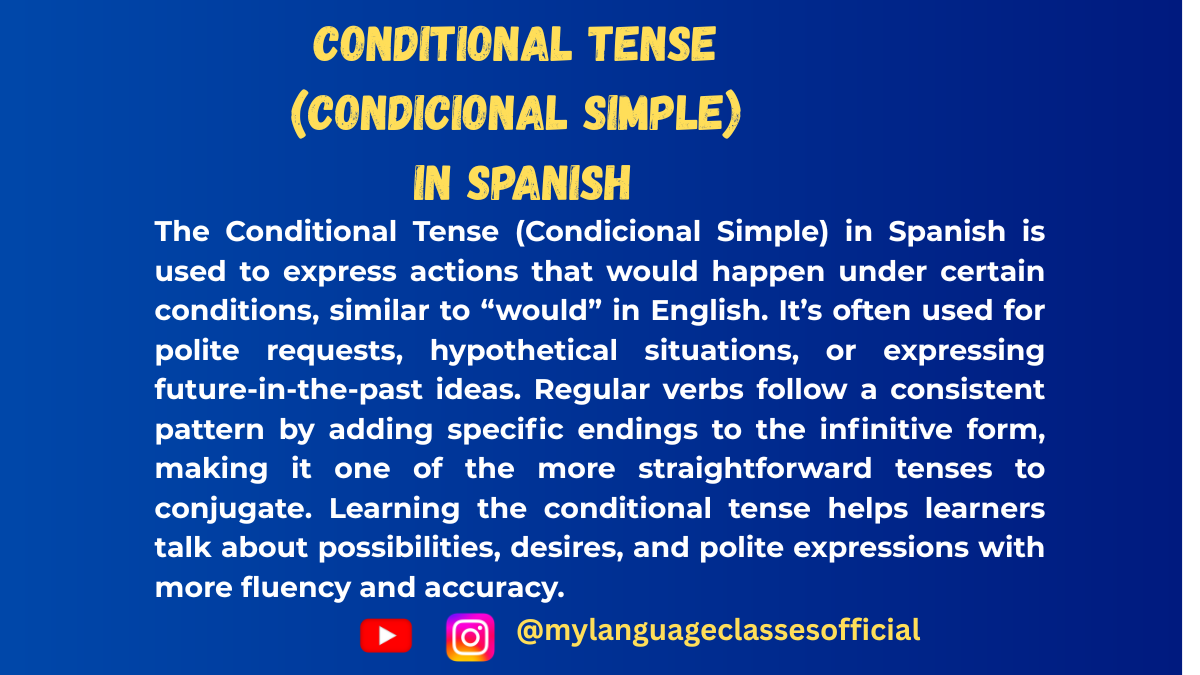
Spanish Conditional Tense (Condicional Simple)
Spanish Conditional Tense (Condicional Simple)
The Conditional tense in Spanish, also known as Condicional Simple, is essential for expressing hypothetical situations, polite requests, advice, or possibilities. It is equivalent to “would” in English and plays a crucial role in day-to-day conversations.
Situations Where Conditional Tense is Used
- Hypothetical Situations
Express unreal or imagined scenarios.
Example:- Si tuviera dinero, viajaría por el mundo.
(If I had money, I would travel the world.)
- Si tuviera dinero, viajaría por el mundo.
- Polite Requests
Used to make polite or formal requests.
Example:- ¿Podrías ayudarme con esto?
(Could you help me with this?)
- ¿Podrías ayudarme con esto?
- Suggestions and Advice
To give recommendations in a softer tone.
Example:- Yo que tú, estudiaría más.
(If I were you, I would study more.)
- Yo que tú, estudiaría más.
- Expressing Desires or Wishes
When talking about what one would like.
Example:- Me gustaría aprender a bailar salsa.
(I would like to learn how to dance salsa.)
- Me gustaría aprender a bailar salsa.
- Future in the Past
When talking about a future action from the perspective of the past.
Example:- Dijo que llamaría después.
(He said he would call later.)
- Dijo que llamaría después.
How to Form the Conditional Tense
1. Regular Verbs
The Conditional tense for regular verbs is formed by adding specific endings to the infinitive form of the verb. These endings are the same for all three conjugations (-ar, -er, -ir).
Endings:
-ía, -ías, -ía, -íamos, -íais, -ían
Examples:
- Hablar (to talk)
- Yo hablaría (I would talk)
- Tú hablarías (You would talk)
- Él/Ella/Usted hablaría (He/She/You would talk)
- Nosotros hablaríamos (We would talk)
- Vosotros hablaríais (You all would talk)
- Ellos/Ellas/Ustedes hablarían (They/You all would talk)
- Comer (to eat)
- Yo comería (I would eat)
- Vivir (to live)
- Yo viviría (I would live)
2. Irregular Verbs
Irregular verbs in the Conditional tense have stem changes, but they use the same endings as regular verbs.
Common Irregular Verbs:
Infinitive Stem Change Conditional Form Example Tener Tendr- Tendría (I would have) Poder Podr- Podría (I could) Venir Vendr- Vendría (I would come) Decir Dir- Diría (I would say) Hacer Har- Haría (I would do/make) Querer Querr- Querría (I would want) Saber Sabr- Sabría (I would know)
Common Expressions in Conditional Tense
- Polite Phrases:
- ¿Podrías ayudarme? (Could you help me?)
- Me encantaría ir contigo. (I would love to go with you.)
- Suggestions:
- Deberías estudiar más. (You should study more.)
- Yo que tú, lo haría. (If I were you, I would do it.)
- Hypotheticals:
- Si fuera rico, viajaría mucho. (If I were rich, I would travel a lot.)
- ¿Qué harías en mi lugar? (What would you do in my place?)
- Future in the Past:
- Ella prometió que vendría temprano. (She promised she would come early.)
Key Considerations:
- Articles and Gender:
Ensure agreement between articles and nouns:- El coche sería rápido. (The car would be fast.)
- La casa estaría lista. (The house would be ready.)
- Plurality:
Match subjects and verbs in number:- Singular: Ella diría. (She would say.)
- Plural: Ellos dirían. (They would say.)
Practice Sentences
- Si tuviera más tiempo, leería más libros.
(If I had more time, I would read more books.) - Nos encantaría visitar España algún día.
(We would love to visit Spain someday.) - ¿Qué harías si ganaras la lotería?
(What would you do if you won the lottery?) - Yo en tu lugar, hablaría con el jefe.
(If I were you, I would talk to the boss.)
Mastering the Conditional tense in Spanish opens up a world of nuanced expression. With practice, you’ll be able to convey politeness, share hypotheticals, and provide advice effortlessly!
If you found this guide helpful, I’d love to hear from you! Share your thoughts in the comments below or connect with me on social media. For more tips, resources, and inspiration, visit my blog at mylanguageclasses.in. Follow on Instagram and subscribe on YouTube
📚 Continue Learning Spanish
- Hypothetical Situations

